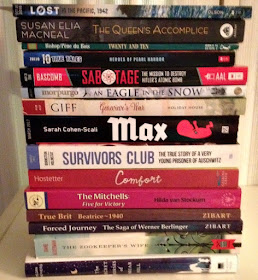Refugees seeking asylum and safety is a old as humanity and a recent as today’s news. It is hard to imagine having to leave the home you have always known, the place you have always thought of as safe, leaving behind your beloved possessions whether it is a doll, or a stuff toy, perhaps pawning your great grandfather’s pocket watch or your great grandmother’s tea service to get money to pay for the trip you and your family are about to embark on. But that is just what these two excellent books are about.
The Journey begins with a young girl, the narrator, introducing her happy close-knit family living in a city near the sea, until war arrives and bad things began to happen. But when the war takes her father, her mother decides it is time to leave their homeland despite the dangers, and to try and reach a country where they can live without war and fear. So the family packs up what belonging they can and leave. But the journey is difficult, and little by little they begin to leave belongings behind to lighten their load and make traveling easier.
The Journey written and illustrated by Francesca Sanna
Flying Eye Books, 2016, 48 pages, age 5+
And they face all kinds of obstacles - a high guarded wall, a sea that stretches far and wide, a scary ferry boat ride, followed by a long train ride, all in search of a home where the family can begin their story all over again.
Sanna used a collage of migration stories from different people she interviewed at a refugee center in Italy to create The Journey, inspired by the story of two girls she met there. Using simple language, and folk art style illustrations, Sanna has written a book that really captured what it is like to be a refugee, to be fleeing friend, family and home for your life with no idea how it will all end. Kids who may have heard about the ongoing problems in Syria this year may greatly benefit from this book, not because it will help them understand the politics of what is happening, but because, on a more personal level, it will help them understand what being a refugee means.
Stepping Stones: A Refugee Family's Journey written by Margriet Ruurs,
artwork by Nizar Ali Badr, translation by Falah Raheem
Orca Books, 2016, 28 pages, age 5+
The story of Rama and her family is similar to the story that the young narrator tells in The Journey and certainly just as compelling. The text is simple and Ruurs has really captured how confusing and frightening it is to go from a life filled with love and serenity to one that knows only fear and upheaval and the hardships refugees experience on their journey. To it credit, the story is written in both English and Arabic, increasing its accessibility to young readers.
What makes this book unusual is the artwork done by Syrian artist Nizar Ali Badr. Using carefully and skillfully placed stones, he has created Rama's tight-knit family and surroundings, creatively capturing all the mixed emotions and feelings that they experience as they flee.
I liked that in The Journey there are no names used for the family, making it a kind of Everyman tale, encompassing all refugees regardless of when, where, or what the circumstances of their leaving might be, while Stepping Stones personalized the story by naming the family members on their journey to freedom and safety, yet both stories are so much the same.
War inevitably leads to people fleeing from the fighting, the persecutions, because their homes, schools, cities, towns and villages have been bombed and/or shelled to smithereens, because of the color of their skin, their religion, or simply because they have been caught in the middle of someone else's war. We see it everyday on the news and so do our children. The Journey and Stepping Stones are two excellent books that will help young readers understand what is happening to the children they see on TV. I can't recommend these two books highly enough.
These books were both purchased for my personal library.











